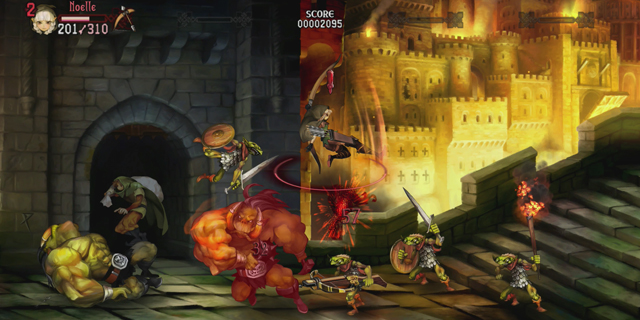
The latest release from Vanillaware, Dragon’s Crown, is a bundle of contradictions. It’s brilliantly elegant, except for the moments when it’s mind-numbingly frustrating. It’s gorgeous and lush, except for the moments when it makes you intensely uncomfortable. It’s a multiplayer-focused design that may be best played solo, and it’s a much-needed evolution of the brawler genre that nevertheless clings tightly to long-outdated mechanics and methods.
In Dragon’s Crown, you control one of six classes, completing tasks and quests on the way to inevitably fighting a huge legendary dragon. The gameplay will be very familiar to those who have played the Dungeons & Dragons arcade games, and that makes sense; George Kamitani, the game’s director, worked on those titles as well. It gets here, though, by way of Vanillaware’s previous work, like Odin Sphere and Muramasa. There are more acrobatic feats here, and the movement and combat are a bit more fluid.
The six classes offer different styles for accomplishing your tasks. the Warrior and Amazon (and, to an extent, the Dwarf) like jumping into huge crowds and slicing through hordes. The Wizard and Sorceress have a pool of limited-use spells to combine with minor attacks, choosing the spots to be devastating and stemming the tide the rest of the time. The Elf is the game’s main ranged threat, and with lots of environmental obstacles and hazards, it can be quite effective to just pick enemies off from afar.
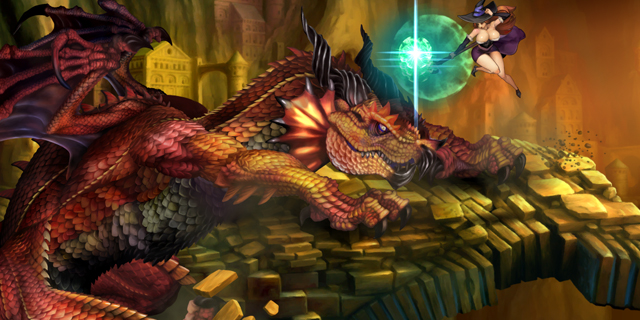
Most of the time, though, you’ll probably just find yourself hitting the square button, as it’s a bit over-mapped. It’s your basic attack. It’s a charge or guard action. It’s the button you hold to dash while running. There are other actions that are duplicated over multiple buttons, so not using a shoulder button to dash, for example, seems a bit weird. For the simpler, easier-to-use characters like the Warrior, it’s more prominent, as you’re juggling the other functions less often.
Your combat style can be shaped to a certain extent by which skills you choose. Each class has its own set to choose from in addition to the common pool of general traits, and the wealth of options means you won’t be getting everything that’s available. Specializing in a few makes for a better strategy, so if you prefer aerial attacks or a certain magic, you’ll be leaving other capabilities and spells by the wayside. Mage classes will make heavy use of the shortcut system, letting you use spells and items by hitting up on the D-pad and a face button simultaneously. Warriors and such will find little reason to switch equipment, as in-mission inventory is very limited, but it’s an option regardless.
You’ll also be sifting through lots of loot to find great new equipment for your character. At the end of each mission, you’re presented with your spoils, but you only know the type of weapon and what general rank it is. To use it or even know any specifics, you must pay to appraise it. If you know it will be weak, you can sell before you appraise and save a bit of cash. Getting loot is fun, but the vast amount of it, the process of getting and equipping it and the occasional frustration of dealing with everyone’s favorite game mechanic, depleting item durability, can get a bit tedious.
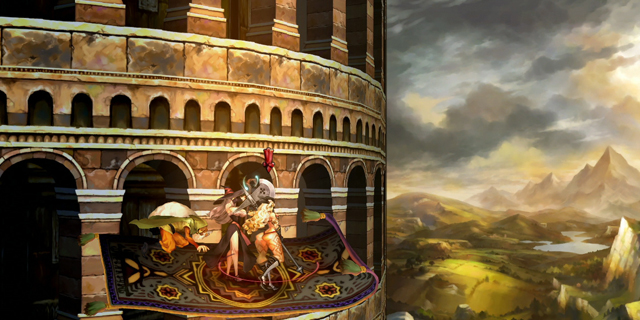
Vanillaware’s signature detailed 2D art is here, and in great form with the increased resolution of both the PS3 and Vita from its previous titles. Small touches, like the rotating map and the subtle sheen of a river, make Dragon’s Crown truly a sight to behold. Pieces of art are quest rewards, and sometimes they’re worth it even without the experience and gold rewards that accompany them. This edition of the Vanillaware style has taken peculiar turns, though, the most prominent of which you’re probably aware: character design.
Two of the game’s six playable classes are the worst offenders: the Sorceress and the Amazon. Both are inadequately clothed, and feature exaggerated proportions that, combined with the game’s flowing animation style, just seem wrong. The other characters are exaggerated, sure, but the Sorceress ends up looking overtly sexualized and the guys just look like they have weird-sized heads or incredibly-large shoulders.
We were hoping that simply not using these classes (and sticking to the counterpart male classes, Wizard and Warrior) would let those who find the designs offensive avoid the objectification for the most part. And, well, not exactly. A few times throughout the story, the game decides to introduce you to a mermaid or bound spirit, who is, for all intents and purposes, not clothed at all and in a provocative pose. It’s really blatant. Thankfully, outside of these story sequences, there’s little else that’s bothersome.
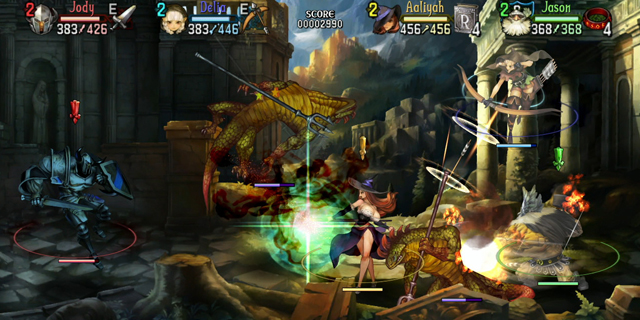
It feels like there simply wasn’t a lead development platform for Dragon’s Crown, as both the PS3 and Vita versions feature elements that feel at home on the other platform. Unlocking chests and doors is a touch-screen action on the Vita, and there are sparkling spots that, if tapped, produce a small treasure item for extra points. This is all done by moving a cursor with the right stick on the PS3, which ends up feeling unwieldy at times. Shouldn’t you be able to open a chest or door by walking up to it? Clicking on an AI companion’s portrait at the top of the screen for revival after death is especially obnoxious, as that needs to happen in the heat of battle. There are also “runes” in the environment to click to form three-rune spells. In practice, we found that triggering them was more trouble than it’s worth, but if you split duties among four players, one may enjoy managing these opportunities.
Similarly, the game puts a focus on multiplayer, both locally and online, and this makes more sense on a home console. Thankfully, both versions look stellar and, outside of design decisions, feel at home. There’s even cross-save functionality if you wish to pick up both, but no cross-play or cross-buy options. If you’re on the fence, we’ll nudge you slightly toward the Vita version, as dealing with “touching” items on PS3 can be frustrating. Even still, you may find it easier to play with friends both locally and online on PS3.
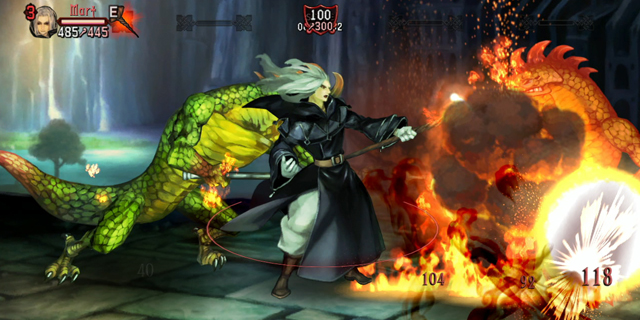
Even though Dragon’s Crown is a multiplayer title, it isn’t particularly well-suited for it. With all the quests, skills and equipment to keep up with, there’s a lot of ducking in and out of menu screens. Only one player can do this at a time locally, and this includes accepting quests. We had some frustrating moments going into a dungeon and fighting all the way through only to find out one of our four-person party hadn’t checked a box at a place in town when the rest of us did. Games are implementing better ways to handle these things on the fly, and Vanillaware should have followed suit. On the other hand, when you’re simply grinding up a character for a while and not fulfilling any specific objectives, playing online is a great way to do it. You can jump right into the action with others, and even pre-release and connecting to largely-Japanese players, we didn’t have any issues.
The color options for each character can be summed up as “slightly-tinted variations of the same super-dark design,” which generally defeats the point. When combat gets furious (which is almost always), it’s difficult to discern between two players of the same class, or even different classes entirely.
When playing alone, you can resurrect piles of bones to serve as AI companions. This is a nice way to fill out the party, and if you go choose which to use before each mission, you can prepare for specific challenges. You’ll have to go choose them, though, because they’re removed from the party after each dungeon, and slowly pop back in at random from your list of resurrected partners if you forget. I guess that’s to simulate the pop-in nature of the online component, but it ends up just being one more frustration.
There’s a lot negative about Dragon’s Crown that must be said, and not because it’s a bad title. Indeed, much of what it does it succeeds at more than any game before it. It simply has some very visible, prominent missteps, and your ability to tolerate them will be the difference between having 120 hours of action-packed joy and being unable to stick it out for more than a few minutes.
Pros: Lush worlds, deep combat mechanics
Cons: Objectionable character designs, menu frustrations



















